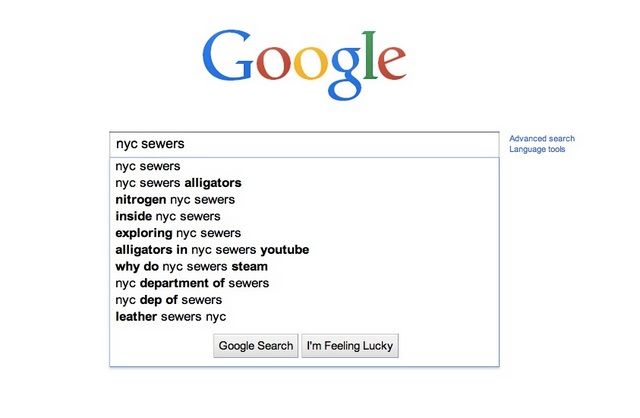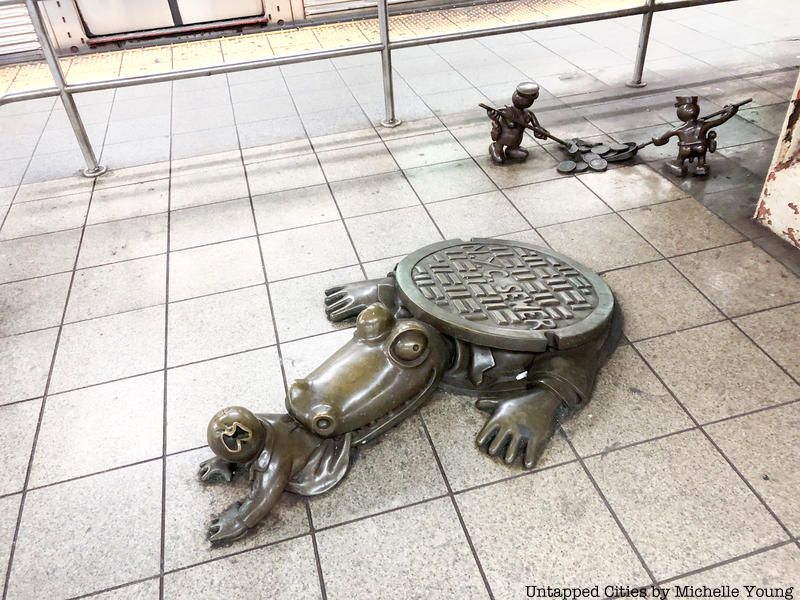NYC’s Forgotten ‘War on Christmas Trees’
Discover how an obscure holiday crackdown affects festive street vendors today!


The NYC Department of Environmental Protection oversees the city’s massive sewer system, employing about 6,000 people. This small army is in charge of the nearly 7,400 miles of sewer pipe that flush a staggering 1.3 billion gallons of water every day. The department is quite friendly and responsive, as far as city services go. Recently, we wrote them to see if we could speak to someone on record. Quickly, a real person responded inviting me to ask away.
So we did. We only had one question.

“Are there now or have there ever been alligators in the New York City sewer system?”
The response came back the next day.
“We have no record of alligators in the NYC sewer system.”
But as definitive as this answer was, the rumor still persists. For example, when searching “NYC sewers” on Google, the term “alligator” auto-populates alongside it.
Alligators may or may not exist in the city’s sewers, but the legend of them remains a part of the New York City mythology. And this likely started in the early 20th century, when, according to legend, it is said that wealthy New York City families went vacationing in warmer, exotic climates and returned with baby alligators as souvenirs; a little something for the kids. The legend goes on to say that after a while the beasts got too big and were flushed down the toilet. Ever since, they have roamed the murky waters of the city sewers, reproducing and subsisting on a diet of plentiful rats.
These origin theories didn’t come out of nowhere, though. They began circulating around the same time actual alligators began popping up around New York City. For instance, in June of 1932, two boys brought a dead 3-foot alligator to the Bronx River Parkway Police with confirmation of at least three more alligators alive and well back at the same spot along the river. The next day a hunting expedition set out, but ultimately found nothing. Still the newspapers reported the next day on “swarms” of the beasts swimming in the Bronx River.
On February 10, 1935, The New York Times reported on a 7-foot, 125 pound alligator turning up in the sewers near 123rd Street in Harlem. According to reports, some neighborhood boys were shoveling snow into a manhole when suddenly they saw a thrashing which they soon realized was an alligator, albeit a diseased one. The boys attached a slip knot around the massive creature and together pulled the animal from the sewer and onto the street. Unfortunately, no pictures were taken of the beast as the city quickly had the reptile incinerated.
Twenty years later the tale popped up again in Robert Daley’s nonfiction book, The World Beneath the City (1959). In the book, Daley recalls a story told to him by New York City’s superintendent of sewers, Teddy May, a man with his own legendary personality. For years, May had heard rumors of alligator congregations from his employees, but figured it was a whiskey-inspired legend. One night he decided to look for himself. Down below the streets he saw:
“Alligators serenely paddling. The beam of his own flashlight had spotted alligators whose length, on the average, was about two feet. Some may have been longer… The colony appeared to have settled contentedly under the very streets of the busiest city in the world.”
The story goes on to describe alligator hunts with an arsenal of “rat poison” and “.22 rifles” among other weaponry. Perhaps these “sewer safaris” eradicated the scourge of sewer gators then. But, there’s also the possibility that it was all made up. Teddy May was not the most reliable of sources and was evidently known to spin yarns.
Sewer alligators have made more than a few appearances in pop culture, too. A few years after Daley’s book, Thomas Pynchon’s debut novel V. (1962) added more voices to the conversation. In the novel, Benny Profane works for New York City’s Alligator Patrol, where two-man teams search underground for alligators, one with a flashlight, the other with a shotgun.
Allusions to sewer alligators can be seen by commuters who frequent the 14th Street station on the 8th Avenue line in the form of Tom Otterness’s art installation, “Life Underground.” The series of sculptures depicts a variety of scenes including an alligator reaching out from underneath a manhole cover to snatch a man for dinner.
And as recently as August 23, 2010, witnesses in Queens reported seeing an 18-inch alligator. “It’s a big mystery,” said police spokesman Officer James Duffy, who was on the scene that day. “It could have been dumped from a car or it could have come out of a sewer.” Turns out it had fallen from a ship and dragged itself from the East River to this spot of gawking residents.
In spite of all these stories, sewer alligators remain a myth or a legend, at least officially. Academically speaking, they exist in the realm of something called cryptozoology, the study of animals whose existence has not yet been proven. The Loch Ness Monster, Skunk Ape and Sasquatch also fall under cryptozoology. Cryptozoology has its detractors. Critics contend it’s more of a pseudo-science that relies too much on anecdotal evidence and not enough on the scientific method. Proponents are quick to point out that both the okapi and the Komodo dragon, two very real animals, were once under the purview of cryptozoology, and thought to be imaginary by so-called serious scientists.
Loren Coleman runs the International Cryptozoology Museum in Portland, Maine. He has written a few books on the subject and even appeared on The History Channel to discuss sewer alligators. According to his email, “Alligators in the sewers are neither rumor, folktale or myth, but a real part of the underground world of some of our larger urban centers.“
Though adamant, his email didn’t provided any specific examples or evidence. But, perhaps simply looking at alligators might provide some credence to the theory that they could survive in the sewers. Research shows that alligators (and also crocodiles) can detect minuscule vibrations in the water through dome pressure receptors on their faces. That is to say, they don’t rely solely on sight for hunting and therefore wouldn’t be totally “in the dark” hunting in the light-deprived sewer system. This is further backed up by the fact that alligators very often hunt at night.
And while it is true that alligators probably prefer something warmer than New York City, the sewers themselves can be quite warm. Most importantly, alligators survived the last Ice Age, which was probably a bit colder than any northeast winter–even this winter. In fact, it is probably foolish to question the adaptability of a creature that has existed for over 30 million years.
Jim Nesci is an alligator expert and reptile educator from the Chicago area. He was a “good friend” of the late Crocodile Hunter, Steve Irwin, and has adopted several rescue reptiles. Nesci points out that any number of alligators could end up in a sewer system. (One of his very own rescue gators was found in a sewage treatment plant in Illinois). However, as he points out, alligators can’t digest food in temperatures below 50 degrees Fahrenheit, making the prospect of surviving a New York City winter, even underground, unlikely. Furthermore, the nests required for laying eggs rely on vegetation more than likely not found in an urban sewer system. As Nesci puts it, “in the short term and only the short term” alligators could survive in a sewer system. But they couldn’t reproduce or thrive there.
In the end, alligator populations probably wouldn’t fare too well in New York City sewers. But, the legend of alligators in the sewer seems to serve some other purposes. For one, New York views itself as a tough place. The idea that even the sewers were teeming with predators bolsters this mystique. New York City is also expansive. Part of the city’s charm is the idea that there is always something new to see. There’s something new to discover on every single street. It only makes sense to think there might be something mysterious underneath those streets, too.
Join Wild City author Thomas Hynes for a virtual talk about the legend of NYC’s sewer alligators! Tickets to this talk are just $10, or free if you are an Untapped New York Insider! You can gain access to unlimited free virtual events per month and unlock a video archive of 100+ past virtual experiences as an Untapped New York Insider starting at $10/month. Already an Insider? Register here! If you can’t make it live, register for this event and we will send you a link to the recording once it airs!

Wild City: NYC’s Sewer Alligators
Next, take a look inside the former Minetta Brook buried under Manhattan but accessible through some manholes downtown and check out an actual Sewer Museum in Paris.
Subscribe to our newsletter